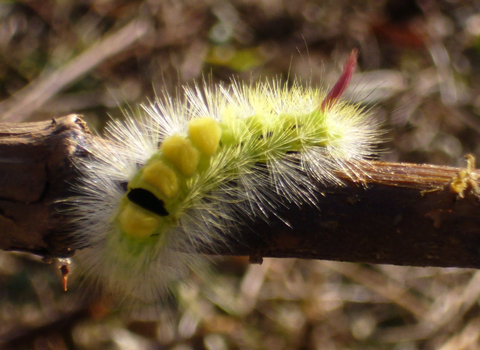
Pale tussock (male) © Amy Lewis

Pale tussock (male) © Amy Lewis

Pale tussock caterpillar ©Lizzie Wilberforce
Pale tussock
This large, fluffy-legged moth is often attracted to lights in May and June.
Enw gwyddonol
Calliteara pudibundaPryd i'w gweld
Adults: May to JuneCaterpillars: July to October
Gwybodaeth am rywogaethau
Ynghylch
Pale tussock moths are found in a wide range of bushy or tree-filled places, from parks and gardens to hedgerows, woodland and scrubby habitats. The adults emerge in spring and can be seen flying between May and June. They're often attracted to lights, with males sometimes turning up in large numbers. With a bit of luck, you might also spot one resting on one of its many foodplants.The bizarre-looking caterpillars feed on a host of broadleaf trees and shrubs, including blackthorn, hawthorns, oaks, hazel, crab apple, and birches. They can often be seen wandering across the ground in autumn, as they get ready to pupate. They spend the winter as a pupa, in a hairy silk cocoon, tucked amongst the leaves of one of their foodplants, or down in the leaf litter below.
Sut i'w hadnabod
A large, grey moth with incredibly hairy legs. At rest, the front two legs are stretched straight out in front of the body - a characteristic pose they share with the similar dark tussock. Males have a band of dark shading across the middle of the wings, as well as feathery orange antennae. Females are much larger, with no feathering on their antennae, and have less-heavily patterned wings. Darker forms of pale tussock can sometimes be found, particularly in males.Although they share the same resting pose as pale tussocks, dark tussocks are easily told apart by the darker colouration, black speckling and orange blotches on the wings. They also fly later in the year, and favour different habitats - preferring heathland, moorland and coastal sites.
Pale tussock caterpillars are even more distinctive. They're bright green or yellow and covered in long hairs that can be yellow, pink or grey. They have a row of four denser tufts of hair on their back, which can be yellow, white or pinkish brown, and a tail-like tuft of red or brown hairs at the end of the body. If the caterpillars are disturbed, they arch their body, revealing jet black patches between the dense tufts on their back.



